
Submission By: Dan McGrath Intro – Why automate your lights? Well, to be honest, most of my house is automated, so it seemed the obvious thing to do. There are lots of benefits in automating parts of your house, lighting in particular just makes life easier, lights coming on when you walk into a room is better than switching them on yourself! ….and because they turn themselves on, they turn themselves off too, so you can’t forget!
The dimmers I have chosen support both 0-10v signal and DMX, and you can use both at once if you like, this is great for me as I’ve set them such that priority is always given to the 0-10v signal, so you have the option of manually overriding the settings that the home automation system sets.
Installation – Ok, lets start at the light switches themselves. Each room has either a double (two lights) or a single dimmer control mounted on the wall. The pictures below show the dimmer control units mounted in the wall, you’ll see they are still unfinished, I’m unable to find suitable looking knobs, like the simple white ones you get on a standard dimmer, so until I do, there are none.
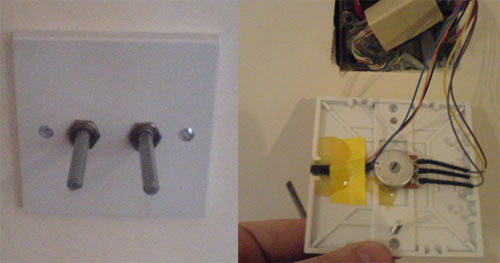
These ‘control units’ look just like standard UK single blanking plates with variable resistors sticking out of the front, and that’s because that is what they are! Below are some pictures showing the insides of these units. First the single dimmer. You’ll notice also that there is a small black device at the bottom of the unit:
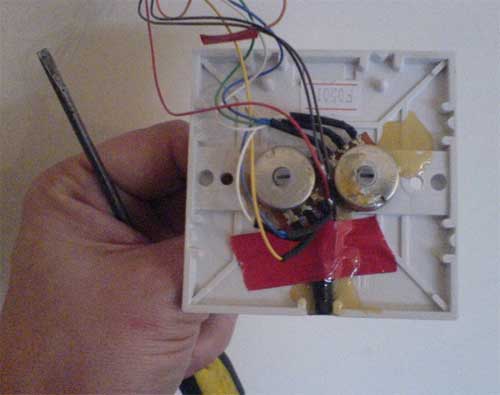
This is a temperature sensor that I use to control the heating, it uses the same enclosure as the dimmer units and the same run of cabling, but they are two separate systems.
The double units are a bit more busy inside, but essentially just two singles in the same box.
These dimmer control units are connected using Cat5e cabling back to my understairs cupboard, where the rest of the kit is. The control units can be easily disconnected from the wall by unplugging their RJ45 plug from the connector. Each dimmer location in the house has a single run of Cat5e to it all home ran back to under the stairs. The units themselves simply act as a potentiometer, the variable resistors have 3 legs, looking from the front, the leftmost one is grounded, the middle one (the wiper) is the output, and the right one gets 10 Volts DC.
Notice the use of heatshrink sleeving and a dab of epoxy to hold everything in place, this makes for a more reliable unit I’ve found Connecting them up in this way means that as you turn them clockwise from off to on, the voltage on the middle leg rises gradually from 0v to 10v – This is used to control the dimmer units manually.
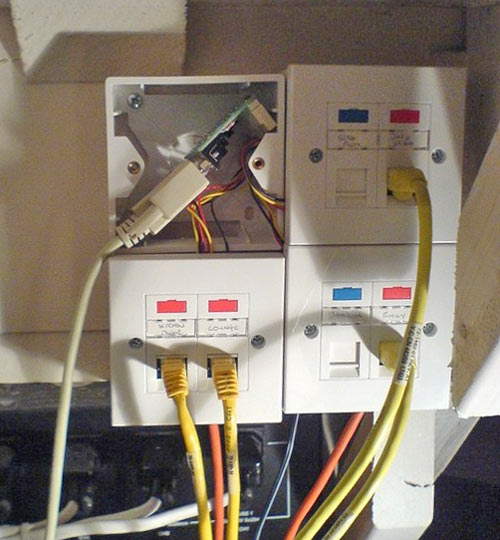
Above are some pictures of how the dimmer control cabling terminates under the stairs, I’ve used standard Cat5e cabling throughout as it is cheap and good quality, I’ve also used RJ45 plugs and connectors for the same reasons, this lighting system has nothing to do with ethernet, tcp-ip or the like, I’m just using the cabling and connectors normally associated with this sort of thing.
In the picture above, each yellow patch cord represents a dimmer control location, I’ve used the RJ45 wall sockets as a means of connecting these cat5e runs up to both the dimmers and the temperature sensor control board. The dimmers themselves are 4 channel units that support both DMX and 0-10v signal to control their output.
I didn’t explain this very well originally, so here is some more information on how the 0-10v signal and DMX work together. The setting of the 0-10v signal (i.e the setting of the dimmer control unit) will (if brighter) override the DMX setting. This isn’t ideal, as it does mean you can leave lights on by mistake, as turning the dimmer all the way up will force the light to stay on.
However, we don’t actually use the dimmer controls manually, the lights come on automatically if it is both dark outside (there is a light sensor in the garden) and if someone is in the room (the PIR sensors tell the server if this is the case). So there is never any need to turn the lights on yourself!
The other potential problem is if the system turned the light on, and you actually wanted to turn it off, turning the dimmer control down would have no effect either. In reality though, the dimmer racks have a configuration switches on them, should I ever experience a difficulty where the server did something I didn’t like, I could either flick one of the DIP switches on the rack, or unplug the DMX lead!! Here’s a link here to the dimmer rack instruction manual which probably explains it better!
The dimmer units take the 0-10v signal on a 5pin DIN connector (1 pin is ground the other 4 represent the 4 channels) and they take the DMX signal on a 3pin XLR connector. DMX devices can be daisy chained as each one has its own id set, if you look closely at the picture above you can see an orange cable (0-10v signal), a purple cable (DMX daisy chain link) and a yellow cable (DMX in from the DMX controller)
Here are some more pictures of the dimmer racks:
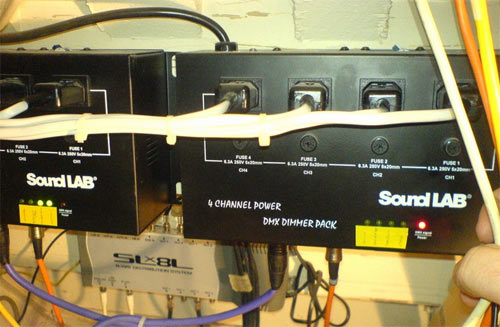
Across the front of the rack you can see a bundle of 1mm T&E cable, each one of these goes to a different lighting location throughout the house. Quite simply this cable runs from the dimmer straight to the light fitting in the ceiling, this does make the wiring of any light fittings very easy, as there is just a single cable to contend with. These cables are connected to the dimmer racks using male IEC connectors (the male version of a kettle lead)
The DMX signals to control the dimmers come from the unit pictured above. This device takes a RS232 (serial) signal from my home automation server and converts it into the DMX protocol. This allows me to control the lighting throughout the house automatically, and means that you don’t actually have to use the dimmer control units in each room, this is really the whole point of automating the lighting, I have sensors in each room (standard security PIR sensors) that are being monitored by my home automation system, if movement is detected then the server sends a serial signal to the DMX controller to bring up the lights in that room etc…
Additionally it means that you can operate your lights over the internet, via SMS, IVR etc.. which can be useful.
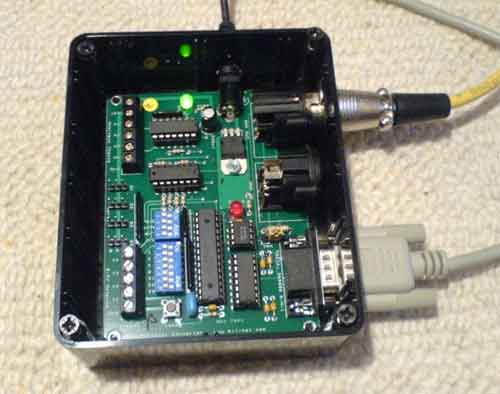
Above are some pictures of the DMX controller fitted in its box, it has three connections, power (12v dc), serial in and DMX out. There is also a link here to the dmx controller instruction manual.
Finally a picure of the rear of the server that connects to the DMX interface, this server is used to control the DMX interface, more about that in the software section below.
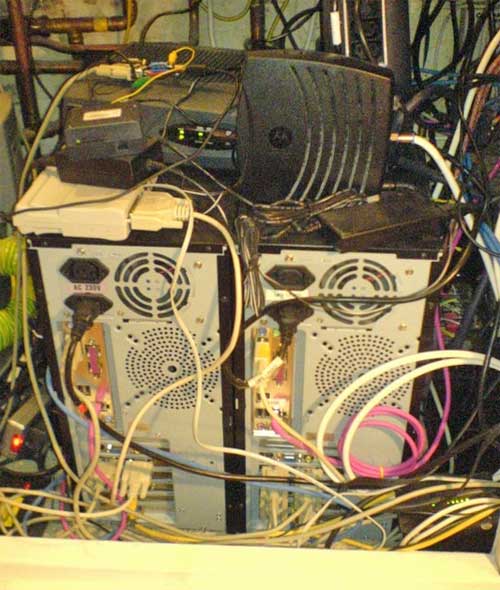
Software – All of my other home automation (security, heating, power, cctv etc..) is written (badly in parts) using perl.
This lighting project is no different, although it does represent my first attempts at using web services.
For the web services I’ve used Apache 2.x and the Soap::Lite module for perl, to actually talk serial to the DMX controller, I have used the perl module Device::SerialPort. The whole lot runs under Redhat Linux I call the web services from my actual home automation application like this: (note this is a part of a much larger program)
# Lights off if no movement for ten minutes and movement more recently in the hallway
#
if ( $epoch – $in11_lastmove > 600 && $in11_lastmove < $in23_lastmove && $kitchenlights == 1 ) {
&send_lights_soap(1,0) ;
$kitchenlights = 0 ;
}
The actual subroutine being called is here:
sub send_lights_soap {
$soap_response = SOAP::Lite
-> uri(‘http://192.168.101.172/Lights’)
-> proxy(‘http://192.168.101.172/cgi-bin/lights’)
-> send( “$_[0]” , “$_[1]” ) ;
$res = $soap_response->result ;
}
And as this is a web service, the actual serial interface and web service code resides on another machine on my network, the web service code looks like this:
#!/usr/bin/perl -w
use SOAP::Transport::HTTP;
SOAP::Transport::HTTP::CGI
-> dispatch_to(‘Lights’)
-> handle;
# Call as -> uri(‘http://192.168.101.172/Lights’)
# -> proxy(‘http://192.168.101.172/cgi-bin/lights’)
# -> send(“” , “”)
package Lights;
sub send {
use Device::SerialPort ;
my $port = Device::SerialPort->new(“/dev/ttyS0”) ;
$port->baudrate(9600) ; $port->parity(“none”) ;
$port->handshake(“none”) ; $port->databits(8) ;
$port->stopbits(1) ; $port->read_char_time(0) ;
$port->read_const_time(1) ;
my ($class , $channel , $intensity ) = @_;
# send data out
$port->write( pack “C”, $channel ) ;
$port->write( pack “C”, $intensity ) ;
sleep(1) ;
$port->close() ;
return “Done! I used $class with chn $channel and inten $intensity”;
}
Fairly simple code, I’m sure you’ll agree, and best of all, because it runs webservices, I can spread these nodes out across my network and call them easily. Additionally you may have noticed that like most people I’ve RFC1918 addressed my network, but with a suitable NAT rule, these services can easily be called from anywhere with an internet connection, meaning that I can control my lighting, heating etc.. from anywhere (even a GPRS or 3G phone!)
Conclusion – Well, I hope you’ve enjoyed what I’ve done, I love my automated lights! Good luck if you decide to do something similar
-Dan
| Item | Supplier | Cost | Quantity | Buy |
| Single Blanking Plate | Maplin | £5.69 | 6 | buy |
| Cat5e Cable | Maplin | £0.69 | 50 | buy |
| 10kohm Linear Pot | Maplin | £1.21 | 8 | buy |
| RJ45 Barrel Connector | Maplin | £4.99 | 6 | buy |
| RJ45 Plug (10pack) | Maplin | £2.49 | 2 | buy |
| 5pin DIN Male Plug | Maplin | £1.69 | 1 | |
| XLR 5pin Male Plug | Maplin | £5.69 | 1 | buy |
| XLR 3pin Female Line Socket | Maplin | £3.79 | 1 | buy |
| XLR 3pin Male Plug | Maplin | £3.79 | 1 | buy |
| IEC Male Plug | Maplin | £2.29 | 1 | buy |
| RS232 to DMX Converter (item 1-463) | Millinst | £65.00 | 1 | buy |
| Soundlab 4channel DMX dimmer (G018VA) | CPC | £58.69 | 2 | buy |
This article was reproduced with kind permission of Dan McGrath from his original article at www.yourmissus.com
Want More? – Follow us on Twitter, Like us on Facebook, or subscribe to our RSS feed. You can even get these news stories delivered via email, straight to your inbox every day.

This is a great article. I am interested in the idea of using ‘stage’ style dimmer packs in a domestic situation. How do they last with 24/7 usage?
So far so good. They’ve been in for about 6 years, and no problems… To be fair though, I think they are rated at about 1500w per channel and they are at most switching 100w
Interesting – can you update again another year later?
I’m looking at this in conjunction with a Loxone control system. There now seem to be a number of low cost DMX RGB LED dimmer/drivers at £25 or less on eBAy as well as the Soundlab type devices you’re using. I also found a 24 channel DMX switch for £200 so the cost per lighting channel looks very low and the kit is cheap to replace if it breaks. The risk presumably then becomes the communications protocol.